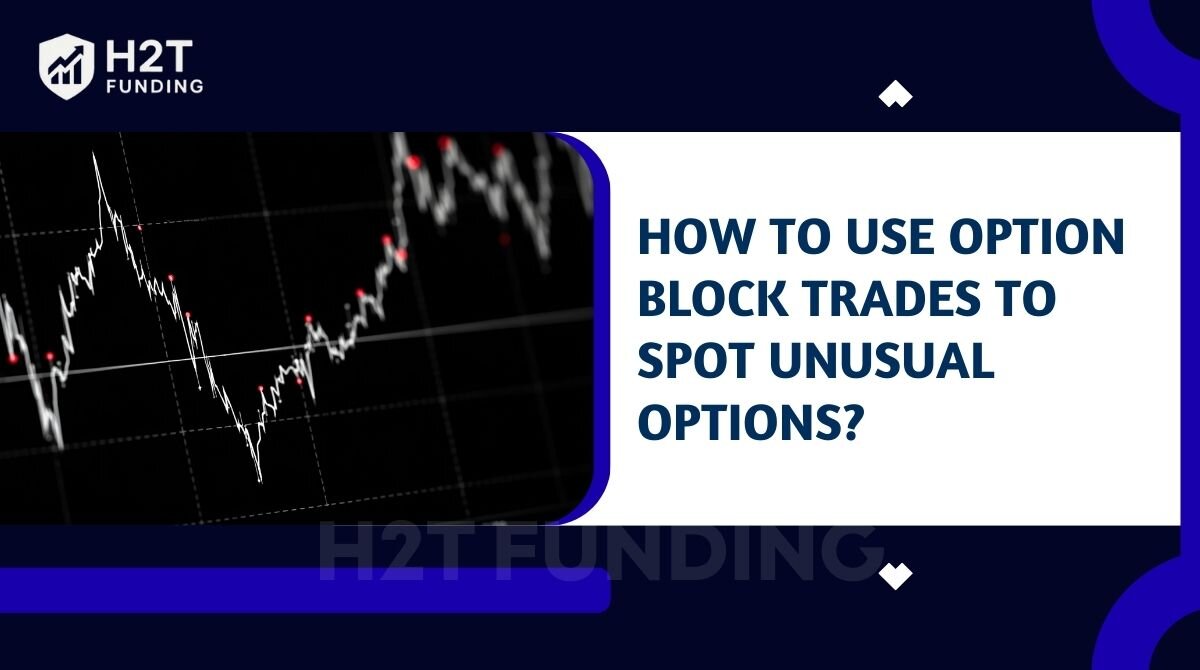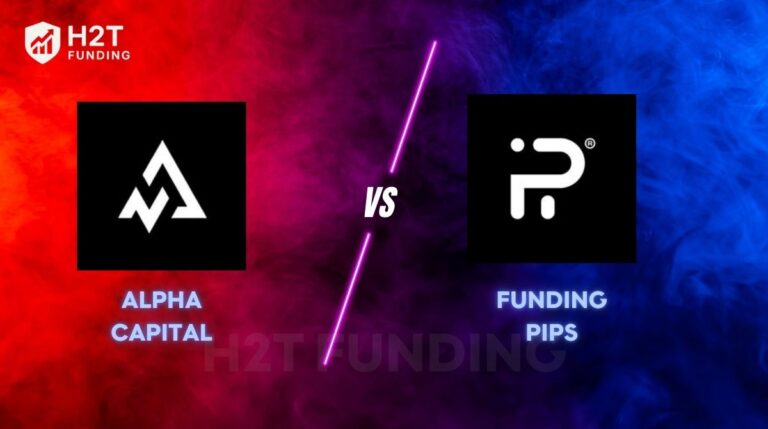Have you ever wondered why some traders always seem to know the market’s next big move? The secret often lies in watching where the big money goes. One of the clearest ways to do that is by learning how to use option block trades to spot unusual options.
In this guide, we’ll show you how to spot these trades, read their signals, and use them to strengthen your own trading strategy.
Key takeaways:
- Unusual Options Activity (UOA) is not just about spikes in trading volume it also includes signals like changes in open interest, block trades, or unusual activity in OTM and short-dated options.
- Institutions use options not only for directional bets but also for hedging, portfolio rebalancing, or generating income through premiums.
- Block trades represent large institutional transactions. Analyzing execution price vs. bid/ask, volume, strike, and expiration is crucial to uncover institutional intent.
- Integrating UOA into strategy allows traders to build watchlists, improve entry/exit confidence, and strengthen overall setups when paired with proper risk management.
1. Understanding the landscape of Unusual Options Activity (UOA)
Unusual options activity is more than just a sudden surge in trading volume. It’s about identifying patterns that suggest informed capital is moving into or out of a particular stock’s options. Understanding these nuances is key to interpreting the signals effectively.
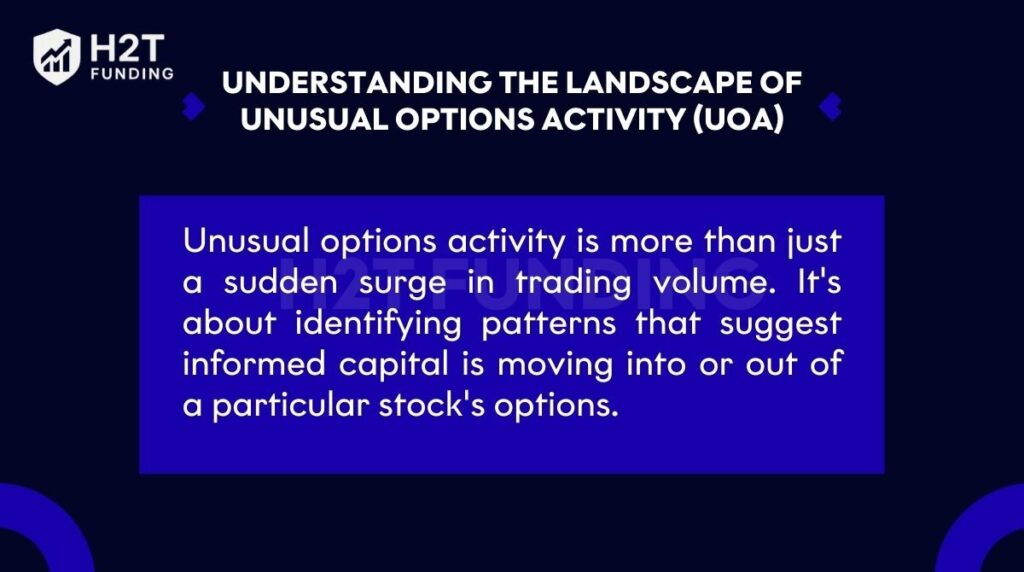
1.1. Beyond just volume: What constitutes unusual?
When we talk about unusual options activity, we’re looking for deviations from the norm. It’s not just about seeing a lot of contracts traded; it’s about the context of that volume.
To truly filter the signal from the noise of regular trading, the key is to focus on these specific indicators. This is how you avoid getting bogged down by meaningless market fluctuations.
- Volume spikes: This is the most straightforward indicator. A sudden, significant increase in contracts traded, far exceeding the average daily volume for that option, immediately draws attention.
- Open interest changes: Volume tells us about current trading, but open interest reveals new money entering the market. If high volume is accompanied by a substantial increase in open interest, it suggests new positions are being opened, indicating fresh conviction. Conversely, high volume with little change in open interest might suggest existing positions are being closed.
- Sweeps versus blocks: While both are forms of large-scale activity, they differ in execution.
- Sweeps: These are orders broken into smaller pieces and executed across multiple exchanges simultaneously. This often indicates a sense of urgency from the buyer or seller.
- Blocks: As discussed, these are single, large, privately negotiated trades. They represent institutional size and often a more deliberate, less urgent positioning. Throughout this guide, we will concentrate on one core skill: how to use option block trades to spot unusual options.
- Out-of-the-money (OTM) activity: When deep out-of-the-money options see unusually high volume, it can be particularly noteworthy. These options are typically cheaper and offer high leverage, so a large investment in them suggests an expectation of a significant price move in the underlying asset.
- Short-dated versus long-dated expiries: The chosen expiration date also provides clues. Short-dated options (expiring in days or weeks) often signal an expectation of an immediate catalyst. Long-dated options (expiring months or even years out) might indicate a longer-term strategic positioning by institutions.
1.2. Why institutions use options
Institutions employ options for a variety of sophisticated reasons. It’s important to remember that not every large options trade is a simple directional bet. Understanding their motivations helps in accurate interpretation.
Just as with understanding leverage in trading, knowing the mechanics behind institutional strategies gives you the clarity needed to interpret unusual options activity correctly.
- Leverage for directional bets: Options allow institutions to gain significant exposure to a stock’s movement with a relatively smaller capital outlay compared to buying or selling the underlying shares.
- Hedging existing stock positions: A significant portion of institutional options activity is for hedging. For example, a fund with a large long stock position might buy protective puts to limit downside risk.
- Generating income: Institutions often sell covered calls against their existing stock holdings or sell cash-secured puts to generate premium income.
- Tax efficiency or portfolio management: Options can be used for various tax strategies or to rebalance portfolios efficiently without directly impacting the underlying stock price immediately.
Crucial point: Not all UOA, even large block trades, are a directional bet. It could very well be hedging. This is a common pitfall for those trying to use option block trades to spot unusual options without understanding the full context.
2. How to use option block trades to spot unusual options
Understanding the theoretical aspects of unusual options activity is one thing; putting it into practice is another. This section will guide you through the practical steps of identifying and beginning to interpret option block trades. A systematic approach isn’t just helpful, it’s crucial here.
2.1. The core principle: Transparency versus opacity
When analyzing market movements, the source and transparency of data are paramount. This is a key distinction when we consider how to use option block trades to spot unusual options.
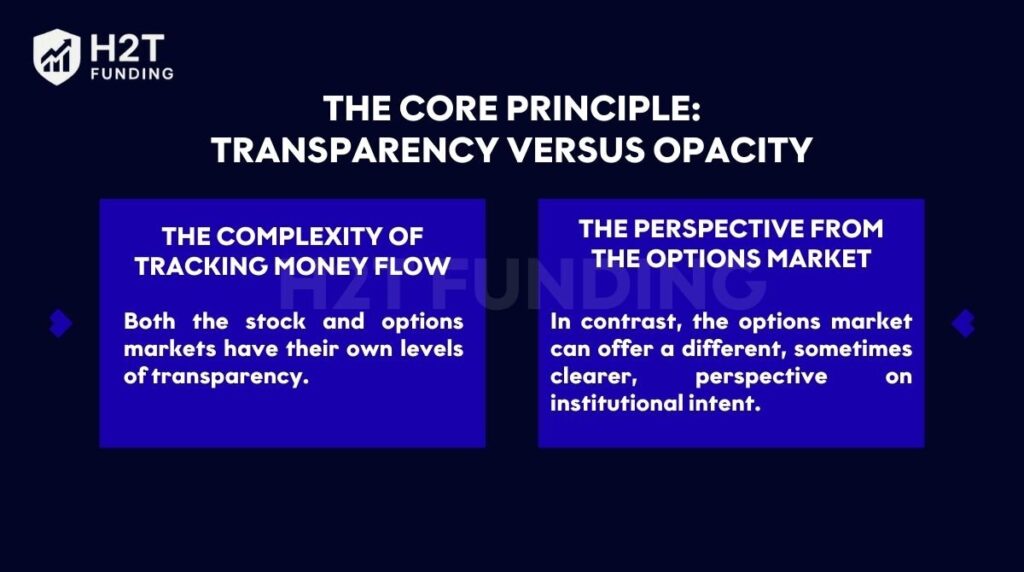
- The complexity of tracking money flow: Both the stock and options markets have their own levels of transparency. In the stock market, a significant portion of trading volume can occur in ‘dark pools’ or through block trades that are reported after execution. While these trades are eventually reported, the delay can make tracking institutional moves in real-time more challenging.
- The perspective from the options market: In contrast, the options market can offer a different, sometimes clearer, perspective on institutional intent. Options order flow, including block trades once they are reported, can provide valuable clues. Therefore, analyzing how to use option block trades to spot unusual options is a key skill for gaining insights that are not as easily visible in the underlying stock market.
2.2. Identifying block trades: Tools and resources
To effectively use option block trades to spot unusual options, you need access to the right tools. Specialized platforms are designed to filter and display this specific type of market data.
2.2.1. Specialized options scanners/platforms
Specialized options scanners/platforms: These are essential for sifting through the vast amount of options data. When looking for a platform, I suggest prioritizing features that allow for granular filtering.
If you are new to interpreting large sets of trading information, you might also benefit from exploring some beginner trading strategies for analyzing market data to build a solid foundation before diving into advanced tools.
You’ll want to find one that offers:
- Real-time or near real-time data: Timeliness is critical for actionable insights.
- Filtering capabilities: The ability to filter by volume, strike price, expiration date, and specifically by call or put options.
- Block trade filters specifically: This is crucial for isolating the large institutional transactions we are interested in.
2.2.2. Understanding data columns
Once you have your scanner, understanding the information presented is the next step. Think of each data column as an essential piece of the puzzle; understanding them is fundamental to how to use option block trades to spot unusual options
- Underlying asset (ticker): The symbol of the stock the option contract is based on.
- Option type (call/put): Indicates whether it’s a call (betting on price increase) or a put (betting on price decrease).
- Expiration date: The date the option contract expires.
- Strike price: The price at which the option can be exercised.
- Premium paid (price per contract): The cost of one option contract.
- Total contracts: The total number of option contracts traded in the block.
- Total notional value: The total dollar value of the trade, calculated as (contracts * strike price * 100) for the underlying value, or (contracts * premium * 100) for the cost of the options.
- Bid/ask spread at time of trade: This is a crucial detail. It tells us where the trade was executed relative to the prevailing bid and ask prices, which can indicate the urgency and directional bias of the trade.
2.3. Decoding the nuances of block trade data
Simply identifying a block trade isn’t enough; the real skill lies in interpreting what it means. The difference between an amateur and an expert trader often lies in the ability to pay attention to these subtle cues. They can reveal a lot about true institutional intent.
- Above or below the mid-price: The price at which a block trade is executed relative to the bid-ask spread is a strong indicator of intent.
- Buying at or near the ask: This suggests aggressive buying. The buyer is willing to pay the higher price to get into the trade immediately, often signaling a bullish conviction.
- Selling at or near the bid: This indicates aggressive selling. The seller is willing to accept the lower price to exit the trade quickly, often signaling a bearish conviction.
- Trading at the mid-price: Trades executed at the mid-price are less clear. They could represent a market maker closing a position or a less urgent transaction, offering a weaker directional bias.
- Large premiums: When a significant amount of money is spent on premiums for an option block trade, it suggests high conviction from the institutional player. They are willing to commit substantial capital, implying they expect a meaningful move in the underlying asset.
- Context of the underlying asset: A block trade never occurs in a vacuum. Its significance is amplified or diminished by the context of the underlying stock.
- Is the stock trending, consolidating, or near key support/resistance levels?
- Are there upcoming earnings reports, major news announcements, or corporate actions that could be influencing the trade? Understanding these factors is vital for a complete picture of how to use option block trades to spot unusual options.
2.4. Step-by-step analysis of a block trade
To systematically analyze block trades and thereby master how to use option block trades to spot unusual options, I apply a structured approach. This helps ensure no critical detail is overlooked.
- Identify the block trade: Start by using your chosen options scanner to filter for significant block trades that meet your criteria.
- Determine directional bias (initial guess): Based on whether it’s a call purchase or a put purchase, form an initial hypothesis about the directional intent (bullish for calls, bearish for puts).
- Analyze the trade price versus bid/ask: Check if the trade was executed at or near the ask (aggressive buy) or at or near the bid (aggressive sell). This refines your initial directional bias.
- Consider open interest versus volume: Compare the volume of the block trade to the existing open interest for that specific option. If volume is much higher than open interest, it’s likely new money entering. If volume is high but open interest remains relatively unchanged, it might be a closing transaction.
- Examine expiration date and strike price: Assess if it’s an aggressive short-term bet (short-dated, deep OTM) or a longer-term strategic positioning (long-dated, closer to the money). A deep OTM option with high volume often signals an expectation of a large move.
- Check for unusual combinations: Sometimes, institutions employ complex strategies. For instance, they might buy calls but simultaneously sell the underlying stock to create a “synthetic put” position, masking a bearish outlook.
- This requires looking at both options and the underlying stock action. To avoid misinterpretation, traders should rely on structured trading plans for interpreting signals that provide a systematic framework for analyzing these complex setups.
- Evaluate the context of the underlying: Finally, consider recent news, technical levels (support, resistance, trendlines), and broader industry trends that might be influencing the institution’s decision. This holistic view is crucial for truly understanding how to use option block trades to spot unusual options.
3. Interpreting block trades: Beyond the obvious
Identifying option block trades is only the first step. The real challenge, and where true insight lies, is in interpreting what these large-scale movements truly signify. One of the truths of the market is that what appears obvious on the surface can often hide a more complex institutional strategy.
3.1. The hedging conundrum
One of the most common misunderstandings when trying to learn how to use option block trades to spot unusual options is assuming every large trade is a directional bet. Institutions frequently use options for risk management.
Explain how institutions use options to hedge existing stock portfolios: Large funds often hold significant equity positions. To protect these holdings from adverse price movements, they might purchase put options. This acts like an insurance policy.
Example: A large put purchase might be protecting a long stock position, not necessarily a bearish bet on the stock itself. To identify this, you might look for abnormally large put purchases on stocks where institutional filings (like 13F reports) show substantial existing long positions. Understanding these trades also provides deeper insights into how institutions manage risk and cash flow when balancing large portfolios.
A covered call position, where an institution sells call options against stock it already owns, is another hedging strategy. This generates income but caps potential upside.
3.2. Synthetic positions
Sophisticated traders and institutions often construct “synthetic” positions using combinations of options and the underlying stock. These strategies can mimic the payoff of a simple long or short stock position but with different capital requirements or risk profiles.
- Synthetic long stock: This position can be created by being long a call option and short a put option at the same strike price and expiration date.
- Synthetic short stock: Conversely, a synthetic short stock position involves being short a call option and long a put option at the same strike price and expiration date.
- Important: Institutions might use these complex strategies to mask their true directional intent. For example, a large call purchase might be part of a synthetic put if the institution simultaneously sells the underlying stock. This allows them to express a bearish view while potentially obscuring it from casual observers.
3.3. The shakeout or false signal
It’s important to maintain a healthy skepticism. Not every significant block trade will lead to the anticipated price movement. This is a hard-won lesson many traders must learn: false signals are an unavoidable part of the game.
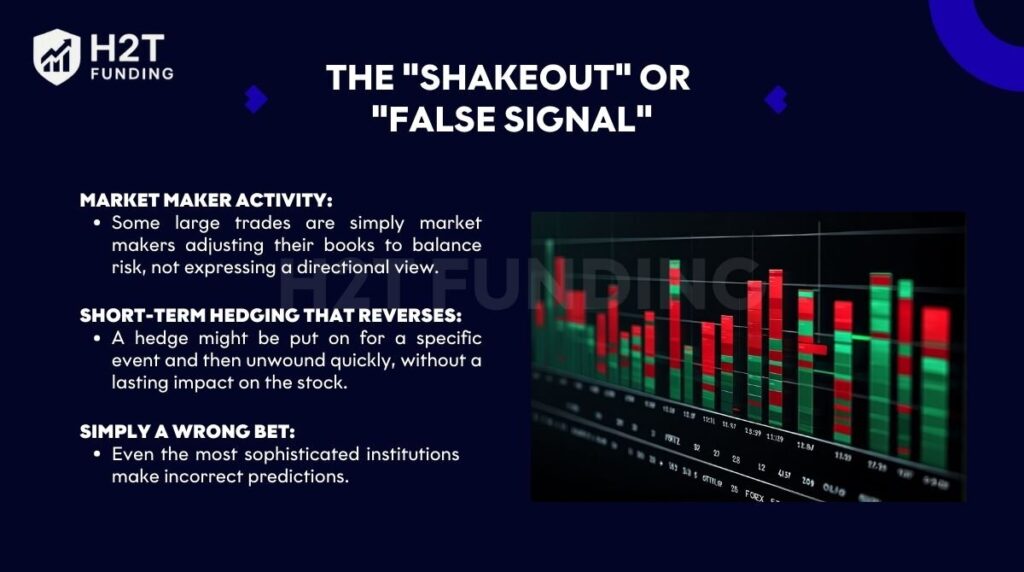
- Acknowledge that not all block trades lead to price movements: The market is dynamic, and even smart money can be wrong or adjust its positions.
- Reasons:
- Market maker activity: Some large trades are simply market makers adjusting their books to balance risk, not expressing a directional view.
- Short-term hedging that reverses: A hedge might be put on for a specific event and then unwound quickly, without a lasting impact on the stock.
- Simply a wrong bet: Even the most sophisticated institutions make incorrect predictions.
3.4. The role of context and confirmation
If there’s one golden rule you need to remember, it’s this: Never rely on a single signal in isolation. Even when mastered, the skill of how to use option block trades to spot unusual options only becomes truly powerful when you combine it with other forms of analysis.
- Confirmation with technical analysis: Always cross-reference block trade signals with the underlying stock’s price action. Look for confirmation from chart patterns, key support and resistance levels, trendlines, and volume on the underlying stock.
- Confirmation with fundamental analysis: Consider the company’s fundamentals, recent news, earnings reports, and industry trends. A block trade might be a reaction to, or anticipation of, a fundamental catalyst.
- Confirmation with macro factors: Broader market sentiment, interest rates, inflation data, and economic reports can all influence institutional decisions. A bullish block trade in a strong sector might be more reliable than one in a struggling sector.
4. Integrating block trade analysis into your trading strategy
Understanding how to use option block trades to spot unusual options is a powerful analytical tool. However, its true value comes when you seamlessly integrate this insight into your overall trading strategy. It’s about building a robust framework, not just chasing signals.
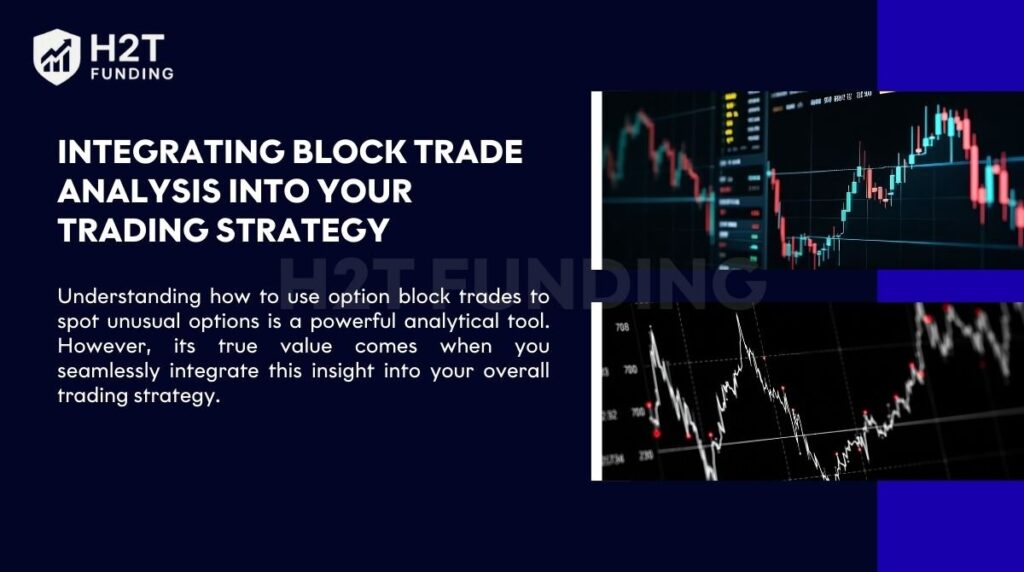
4.1. Developing a watchlist based on UOA
A proactive approach to unusual options activity begins with systematic monitoring. This allows you to stay ahead of potential moves rather than reacting to them.
- How to systematically filter and monitor for significant block trades: Start by setting up your options scanner (as discussed in Section II) to filter for block trades that meet your specific criteria for size, strike, and expiration. You might focus on trades above a certain notional value or a percentage of the average daily volume.
- Setting alerts for unusual activity: Most advanced options platforms allow you to set real-time or near-real-time alerts. Configure these alerts for specific tickers, industries, or types of unusual activity that align with your trading focus.
This ensures you’re notified immediately when a significant block trade occurs. For traders participating in funded accounts, having real-time alerts when trading funded challenges can be a game-changer, helping them react quickly and protect capital.
4.2. Entry and exit strategies
Block trades provide valuable clues, but they rarely offer precise entry and exit points. My approach is to use them as a confirmation or a catalyst for further investigation.
4.2.1. Entry
Use UOA as a confirmation signal for a trade idea rather than the sole trigger. If you’ve already identified a potential trade based on technical or fundamental analysis, a coinciding block trade can add conviction. Wait for technical confirmation, such as a breakout from a resistance level or a bounce off support, after a block trade has been identified.
4.2.2. Exit
Block trades do not directly provide exit signals. Instead, define clear profit targets and stop-loss levels based on your overall trading plan and technical analysis. While UOA might hint at potential resistance or support levels where institutions are positioning, your exit strategy should be pre-determined and based on your risk management rules.
4.3. Risk management principles for options trading
No matter how sophisticated your analysis of how to use option block trades to spot unusual options, effective risk management is paramount. This is the foundation of sustainable trading.
- Position sizing based on account size and risk tolerance: Never allocate too much capital to a single trade. Determine a fixed percentage of your total trading capital you are willing to risk on any given trade (e.g., 1-2%).
- Setting clear stop-loss orders: Always define your maximum acceptable loss before entering a trade. For options, this might involve setting a price point on the underlying stock that invalidates your trade idea, or a specific percentage loss on the option premium itself.
- Never risking more than a small percentage of your capital on any single trade: This rule protects your capital from unexpected market moves and helps ensure you can continue trading even after a losing trade.
- Understanding options decay (theta): Options lose value over time, a phenomenon known as theta decay. Factor this into your trade duration and selection of expiration dates, especially for long option positions.
4.4. Backtesting and continuous learning
The market is an ever-evolving entity, and what worked yesterday might not work tomorrow. This is why constant adaptation is not a choice, but a necessity.
Emphasize the importance of testing strategies using historical data: Before deploying any strategy involving how to use option block trades to spot unusual options with real capital, backtest it rigorously. Analyze how similar block trades performed in the past under various market conditions.
Because the market constantly evolves, continuous learning and adaptation are crucial. The best traders are perpetual learners, always refining their approach.
5. Common mistakes to avoid when using option block trades
While understanding how to use option block trades to spot unusual options can be a powerful edge, it’s also an area ripe for misinterpretation. My observations have highlighted several common pitfalls that traders should actively avoid.
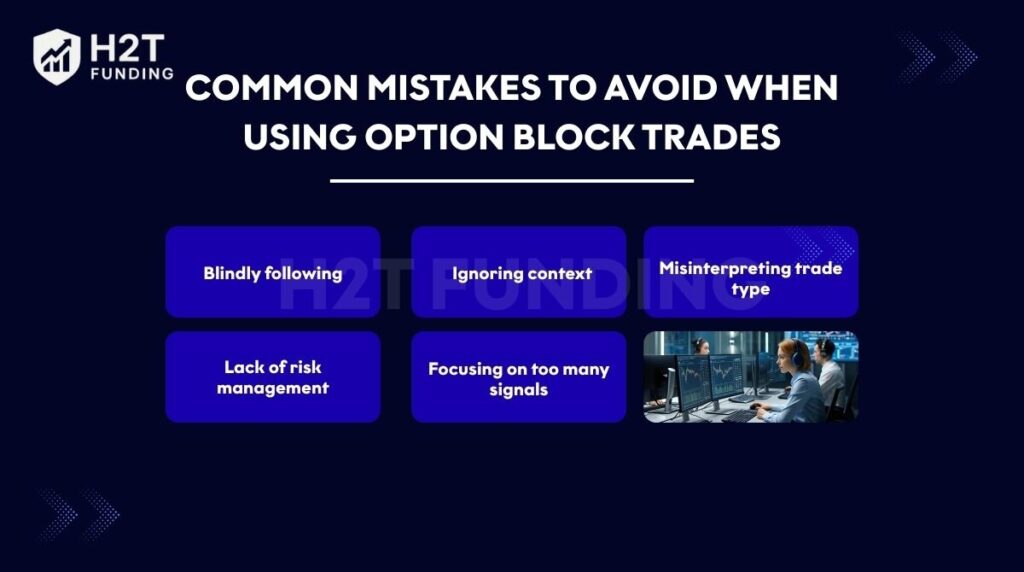
5.1. Blindly following
One of the biggest mistakes is to treat block trades as infallible signals. The market is complex, and even large institutions can be wrong or have motivations that aren’t immediately obvious.
- Assuming all large trades signal a guaranteed future move: This is a dangerous assumption. A block trade indicates a significant transaction, not a prophecy.
- Not considering the full context: Without understanding why a trade was placed, simply mirroring it can lead to poor outcomes.
5.2. Ignoring context
As I’ve stressed throughout this guide, the isolated block trade tells only a part of the story. Its true meaning emerges when viewed within a broader market picture.
- Not considering technical, fundamental, or broader market factors: Relying solely on UOA without cross-referencing with price action, company news, or overall economic trends is a recipe for misjudgment.
- Missing the bigger picture: A block trade might be a small piece of a much larger, more complex institutional strategy that you are not privy to.
5.3. Misinterpreting trade type
Not all large options trades are aggressive directional bets. Many are for hedging or other sophisticated purposes.
- Not differentiating between aggressive directional bets and hedging activity: As discussed, a large put purchase might be protective, not purely bearish. Failing to make this distinction can lead to incorrect conclusions.
- Overlooking synthetic positions: Complex option strategies can mask true intent. Without a deeper understanding, you might misread the institution’s actual market view.
5.4. Lack of risk management
Even with the best analysis, trading involves risk. Neglecting fundamental risk management principles is a critical error. A solid approach requires understanding drawdown and risk exposure so traders can protect their capital and sustain performance over the long term.
- Overleveraging or not setting stop-losses: This is a direct path to significant losses. Options offer high leverage, which can amplify both gains and losses.
- Failing to define your maximum risk: Entering a trade without a clear exit strategy for when it goes wrong is speculative, not strategic.
5.5. Focusing on too many signals
In the age of abundant data, it’s easy to become overwhelmed. Trying to track every single unusual option activity can lead to analysis paralysis.
- Getting overwhelmed by data: Too much information can be as detrimental as too little. Focus on the most significant and relevant block trades.
- Losing sight of your own trading plan: UOA should complement your strategy, not dictate it entirely. Stick to your defined rules and criteria.
6. FAQs
Block trade: A single, large, privately negotiated options transaction, typically 10,000 contracts or more, reported after execution. It often indicates a deliberate, large institutional position. Sweep trade: An order broken into smaller pieces and executed across multiple exchanges simultaneously to fill the order quickly. It suggests urgency and a strong conviction from the buyer or seller.
UOA can provide strong indications of potential future price movements, as it often reflects “smart money” positioning. However, it is not a guaranteed predictor. It should always be used as a confirming signal alongside other forms of analysis.
Reliable data on option block trades is typically available through specialized options analytics platforms and data providers. Many offer scanners and filters specifically for unusual options activity, including block trades.
No, it is generally not safe to blindly copy option block trades. Institutions have complex reasons for their trades, including hedging, synthetic positions, or long-term strategies that may not align with an individual trader’s goals or risk tolerance. Always conduct your own analysis and apply proper risk management.
The frequency depends on your trading style. Day traders might monitor in real-time, while swing traders or long-term investors might check daily or weekly. Setting up alerts on your chosen platform can help you stay informed without constant manual monitoring.
7. Conclusion: Empowering your trading decisions with smart money insights
Understanding how to use option block trades to spot unusual options is a skill that can truly empower your trading decisions. It offers a unique window into the actions of large institutional investors, providing insights that are often hidden from the broader market.
By learning to identify, interpret, and integrate these signals, you can gain a more comprehensive view of market sentiment and potential future movements.
However, as we’ve explored, this is not about blindly following. It’s about:
- Diligent analysis: Looking beyond the surface to understand the true intent behind large trades.
- Contextual understanding: Always combining UOA with technical, fundamental, and macroeconomic analysis.
- Robust risk management: Protecting your capital is always the top priority, regardless of the signals you observe.
We believe that informed traders are successful traders. We encourage you to delve deeper into the world of options and explore how these insights can enhance your trading framework.
For more in-depth knowledge and strategies, be sure to explore our Prop Firm & Trading Strategies section on H2T Funding.

